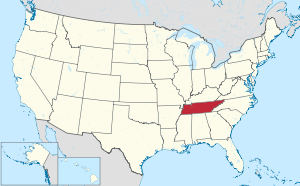Davidson County, Tennessee
Davidson County is a county in the U.S. state of Tennessee. It is located in the heart of Middle Tennessee. As of the 2010 census, the population was 626,681,[2] making it the second-most populous county in Tennessee, after Shelby County. Its county seat is Nashville,[3] the state capital.
Davidson County | |
|---|---|
 Davidson County Courthouse, Tennessee State Capital | |
 Seal | |
 Location within the U.S. state of Tennessee | |
 Tennessee's location within the U.S. | |
| Coordinates: 36.17°N 86.78°W | |
| Country | |
| State | |
| Founded | October 6, 1783 |
| Named for | William Lee Davidson[1] |
| Seat | Nashville |
| Largest city | Nashville |
| Area | |
| • Total | 526 sq mi (1,360 km2) |
| • Land | 504 sq mi (1,310 km2) |
| • Water | 22 sq mi (60 km2) 4.2%% |
| Population | |
| • Estimate (2019) | 694,144 |
| • Density | 1,326/sq mi (512/km2) |
| Time zone | UTC−6 (Central) |
| • Summer (DST) | UTC−5 (CDT) |
| Congressional district | 5th |
| Website | www |
In 1963, the City of Nashville and the Davidson County government merged, so the county government is now known as the "Metropolitan Government of Nashville and Davidson County", or "Metro Nashville" for short.
Davidson County has the largest population in the 13-county Nashville-Davidson–Murfreesboro–Franklin Metropolitan Statistical Area. Nashville has always been the region's center of commerce, industry, transportation, and culture, but it did not become the capital of Tennessee until 1827 and did not gain permanent capital status until 1843.[1]
History
Davidson County is the oldest county in the 41-county region of Middle Tennessee. It dates to 1783, shortly after the end of the American Revolution, when the North Carolina legislature created the county and named it in honor of William Lee Davidson,[4] a North Carolina general who was killed opposing the crossing of the Catawba River by General Cornwallis's British forces on February 1, 1781. The county seat, Nashville, is the oldest permanent European settlement in Middle Tennessee, founded by James Robertson and John Donelson during the winter of 1779–80 and the waning days of the Revolutionary War.
The first white settlers established the Cumberland Compact to establish a basic rule of law and to protect their land titles. Through much of the early 1780s, the settlers also faced a hostile response from the Native American tribes, such as the Cherokee, Muscogee (Creek), and Shawnee who while not living in the area used is as a hunting ground and resented the newcomers moving into there and competing for its resources. As the county's many known archaeological sites attest, Native American cultures had occupied areas of Davidson County for thousands of years. The first white Americans to enter the area were fur traders. Long hunters came next, having heard about a large salt lick, known as French Lick, where they hunted game and traded with the Native Americans.[1]
In 1765, Timothy Demonbreun, a hunter, trapper, and former Governor of Illinois under the French, and his wife lived in a small cave (now known as Demonbreun's Cave) on the south side of the Cumberland River near present-day downtown Nashville. They were the parents of the first white child to be born in Middle Tennessee.[5] A number of the settlers came from Kentucky and the Upper South. Since the land was fertile, they cultivated hemp and tobacco, using the labor of enslaved African Americans, and also raised blooded livestock of high quality, including horses. Generally holding less land than the plantations of Western Tennessee, many Middle Tennessee planters nevertheless became wealthy during this period.

Davidson County was much larger when it was created in 1783. However, four more counties were carved out of Davidson County's territory between 1786 and 1856.[6][7]
- Sumner County created in 1786
- Williamson County, created in 1799
- Rutherford County, created in 1803 (also included parts of Wilson County)
- Cheatham County, created in 1856 (also included parts of Dickson, Montgomery and Robertson counties)
In the June 8, 1861, referendum, the voters of Davidson County voted narrowly in favor of secession: 5,635 in favor, 5,572 against.[8] However, the Union Army occupied the county in February 1862, which caused widespread social disruption as the state's governing institutions broke down.
Notable residents
- See List of people from Nashville, Tennessee for notable people that were residents of both Nashville and Davidson County.
- Newman Haynes Clanton – Democrat, western cattle rustler and outlaw
Geography
According to the U.S. Census Bureau, the county has a total area of 526 square miles (1,360 km2), of which 504 square miles (1,310 km2) is land and 22 square miles (57 km2) (4.2%) is water.[9]
The Cumberland River flows from east to west through the middle of the county. Two dams within the county are Old Hickory Lock and Dam and J. Percy Priest Dam, operated by the United States Army Corps of Engineers. Important tributaries of the Cumberland in Davidson County include Whites Creek, Manskers Creek, Stones River, Mill Creek, and the Harpeth River.[10]
Adjacent counties
- Robertson County, Tennessee – north
- Sumner County, Tennessee – northeast
- Wilson County, Tennessee – east
- Rutherford County, Tennessee – southeast
- Williamson County, Tennessee – south
- Cheatham County, Tennessee – west
National protected area
- Natchez Trace Parkway (part)
State protected areas
- Bicentennial Mall State Park
- Couchville Cedar Glade State Natural Area (part)
- Harpeth River State Park (part)
- Hill Forest State Natural Area
- Long Hunter State Park (part)
- Mount View Glade State Natural Area
- Percy Priest Wildlife Management Area (part)
- Radnor Lake State Natural Area
Demographics
| Historical population | |||
|---|---|---|---|
| Census | Pop. | %± | |
| 1790 | 3,459 | — | |
| 1800 | 9,965 | 188.1% | |
| 1810 | 15,608 | 56.6% | |
| 1820 | 20,154 | 29.1% | |
| 1830 | 28,122 | 39.5% | |
| 1840 | 30,509 | 8.5% | |
| 1850 | 38,882 | 27.4% | |
| 1860 | 47,055 | 21.0% | |
| 1870 | 62,897 | 33.7% | |
| 1880 | 79,026 | 25.6% | |
| 1890 | 108,174 | 36.9% | |
| 1900 | 122,815 | 13.5% | |
| 1910 | 149,478 | 21.7% | |
| 1920 | 167,815 | 12.3% | |
| 1930 | 222,854 | 32.8% | |
| 1940 | 257,267 | 15.4% | |
| 1950 | 321,758 | 25.1% | |
| 1960 | 399,743 | 24.2% | |
| 1970 | 448,003 | 12.1% | |
| 1980 | 477,811 | 6.7% | |
| 1990 | 510,784 | 6.9% | |
| 2000 | 569,891 | 11.6% | |
| 2010 | 626,681 | 10.0% | |
| Est. 2019 | 694,144 | [11] | 10.8% |
| U.S. Decennial Census[12] 1790–1960[13] 1900–1990[14] 1990–2000[15] 2010–2019[2] | |||
As of the census[17] of 2000, there were 569,891 people, 237,405 households, and 138,169 families residing in the county. The population density was 1,135 people per square mile (438/km2). There were 252,977 housing units at an average density of 504 per square mile (194/km2). The racial makeup of the county was 67.0% White, 26.0% Black or African American, 0.3% Native American, 2.3% Asian, 0.1% Pacific Islander, 2.4% from other races, and 2.0% from two or more races. 4.6% of the population were Hispanic or Latino of any race.
In 2005 the racial makeup of the county was 61.7% non-Hispanic white, 27.5% African-American, 6.6% Latino and 2.8% Asian.
In 2000 there were 237,405 households out of which 26.7% had children under the age of 18 living with them, 39.9% were married couples living together, 14.3% had a female householder with no husband present, and 41.8% were non-families. 33.4% of all households were made up of individuals and 8.2% had someone living alone who was 65 years of age or older. The average household size was 2.30 and the average family size was 2.96.
In the county, the population was spread out with 22.2% under the age of 18, 11.6% from 18 to 24, 34.0% from 25 to 44, 21.1% from 45 to 64, and 11.1% who were 65 years of age or older. The median age was 34 years. For every 100 females, there were 93.80 males. For every 100 females age 18 and over, there were 90.80 males.
The median income for a household in the county was $39,797, and the median income for a family was $49,317. Males had a median income of $33,844 versus $27,770 for females. The per capita income for the county was $23,069. About 10.0% of families and 13.0% of the population were below the poverty line, including 19.1% of those under age 18 and 10.5% of those age 65 or over.
Politics
Like most large urban counties, Davidson County is a Democratic stronghold. The last Republican to carry this county was George H.W. Bush in 1988. Unlike the rest of Tennessee, however, Davidson County has actually shifted more towards the Democratic Party in recent years. In 2016, Hillary Clinton won the highest percentage of the popular vote in the county of any Democratic presidential candidate since 1976, whereas Clinton only carried two other counties in the state, Shelby and Haywood, the fewest counties a Democratic presidential candidate has ever carried in the state's history.
| Year | Republican | Democratic | Third Parties |
|---|---|---|---|
| 2016 | 34.0% 84,550 | 59.8% 148,864 | 6.3% 15,654 |
| 2012 | 39.8% 97,622 | 58.3% 143,120 | 2.0% 4,792 |
| 2008 | 38.8% 102,915 | 59.7% 158,423 | 1.5% 3,885 |
| 2004 | 44.5% 107,839 | 54.8% 132,737 | 0.7% 1,726 |
| 2000 | 40.3% 84,117 | 57.8% 120,508 | 1.9% 3,963 |
| 1996 | 39.2% 78,453 | 55.3% 110,805 | 5.6% 11,124 |
| 1992 | 37.6% 76,567 | 52.2% 106,355 | 10.2% 20,885 |
| 1988 | 52.2% 98,599 | 47.3% 89,270 | 0.6% 1,077 |
| 1984 | 52.0% 98,155 | 47.4% 89,498 | 0.6% 1,161 |
| 1980 | 37.5% 65,772 | 59.1% 103,741 | 3.5% 6,093 |
| 1976 | 37.5% 60,662 | 61.3% 99,007 | 1.2% 1,929 |
| 1972 | 61.3% 82,636 | 36.3% 48,869 | 2.4% 3,292 |
| 1968 | 32.3% 44,175 | 32.6% 44,543 | 35.1% 47,889 |
| 1964 | 36.4% 45,335 | 63.7% 79,387 | |
| 1960 | 46.3% 52,077 | 53.0% 59,649 | 0.8% 871 |
| 1956 | 39.1% 37,077 | 59.9% 56,822 | 1.0% 975 |
| 1952 | 41.0% 35,916 | 58.8% 51,562 | 0.2% 152 |
| 1948 | 22.3% 8,410 | 55.5% 20,877 | 22.2% 8,356 |
| 1944 | 27.7% 10,174 | 72.1% 26,493 | 0.3% 93 |
| 1940 | 24.1% 8,763 | 75.9% 27,589 | |
| 1936 | 14.8% 4,467 | 84.7% 25,530 | 0.5% 161 |
| 1932 | 24.4% 7,004 | 74.1% 21,233 | 1.5% 429 |
| 1928 | 53.2% 15,322 | 46.7% 13,442 | 0.1% 34 |
| 1924 | 26.2% 4,516 | 65.9% 11,363 | 7.9% 1,370 |
| 1920 | 33.5% 6,811 | 65.6% 13,354 | 0.9% 181 |
| 1916 | 25.7% 3,168 | 72.7% 8,958 | 1.6% 194 |
| 1912 | 11.4% 1,428 | 76.3% 9,517 | 12.3% 1,536 |
Federal officers
- U.S. Senators: Lamar Alexander (R) and Marsha Blackburn (R)
- U.S. Representatives: Jim Cooper (D – District 5)
State officers
- State Senators: Brenda Gilmore (D), Steven Dickerson (R), Jeff Yarbro (D), and Ferrell Haile (R)
- State Representatives: Bo Mitchell (D), Bill Beck (D), Mike Stewart (D), Jason Powell (D), Vincent Dixie (D), John Ray Clemmons (D), Bob Freeman (D), Harold Love (D), Jason Potts (D), Darren Jernigan (D)
Local officers
- Mayor: John Cooper
- Vice Mayor and Metropolitan Council President: Jim Shulman
- City Council: see Metropolitan Council of Nashville and Davidson County
Communities
All of Davidson County is encompassed under the consolidated Metropolitan Government of Nashville and Davidson County. However, several municipalities that were incorporated before consolidation retain some autonomy as independent municipalities. These are:
- Belle Meade
- Berry Hill
- Forest Hills
- Goodlettsville (partly in Sumner County)
- Oak Hill
- Ridgetop (primarily in Robertson County)
For U.S. Census purposes, the portions of Davidson County that lie outside the boundaries of the six independently incorporated municipalities are collectively treated as the Nashville-Davidson balance.
Unincorporated communities
In addition, several other communities in the county that lack the official status of incorporated municipalities (either because they were never incorporated or because they relinquished their municipal charters when consolidation occurred) maintain their independent identities to varying degrees. These include:
- Antioch
- Bellevue
- Bellshire
- Bordeaux
- Donelson
- Hermitage
- Inglewood
- Joelton (partly in Cheatham County)
- Lakewood
- Madison (includes historical Haysboro)
- Old Hickory
- Pasquo
- Whites Creek
- Woodbine
- Una
- Rosebank
- Bakertown
- Smith Springs
Notable people
- Jermain Wesley Loguen, abolitionist leader
- Benjamin "Pap" Singleton, abolitionist leader
References
- Carroll Van West, "Davidson County," Tennessee Encyclopedia of History and Culture. Retrieved: June 26, 2013.
- "State & County QuickFacts". United States Census Bureau. Archived from the original on June 29, 2011. Retrieved November 29, 2013.
- "Find a County". National Association of Counties. Archived from the original on May 31, 2011. Retrieved June 7, 2011.
- Gannett, Henry (1905). The Origin of Certain Place Names in the United States. Govt. Print. Off. p. 101.
- Thomas C. Barr, Jr., "Caves of Tennessee", Tennessee Division of Geology, Bulletin 64, 1961, p 148.
- see List of counties in Tennessee for sourcing
- Lewis, Samuel (1817). "State of Tennessee". Retrieved July 11, 2019.
- Lovett, B.L. The African-American History of Nashville, Tn: 1780–1930 (p). University of Arkansas Press. p. 45. ISBN 978-1-61075-412-5. Retrieved October 16, 2014.
- "2010 Census Gazetteer Files". United States Census Bureau. August 22, 2012. Retrieved April 4, 2015.
- Morris, Eastin (1834). Tennessee Gazetteer. Nashville: W. Hasell Hunt & Co.
- "Population and Housing Unit Estimates". Retrieved March 26, 2020.
- "U.S. Decennial Census". United States Census Bureau. Retrieved April 4, 2015.
- "Historical Census Browser". University of Virginia Library. Retrieved April 4, 2015.
- Forstall, Richard L., ed. (March 27, 1995). "Population of Counties by Decennial Census: 1900 to 1990". United States Census Bureau. Retrieved April 4, 2015.
- "Census 2000 PHC-T-4. Ranking Tables for Counties: 1990 and 2000" (PDF). United States Census Bureau. April 2, 2001. Retrieved April 4, 2015.
- Based on 2000 census data
- "U.S. Census website". United States Census Bureau. Retrieved May 14, 2011.
- Leip, David. "Dave Leip's Atlas of U.S. Presidential Elections". uselectionatlas.org. Retrieved March 10, 2018.
Further reading
- Nashville, Chattanooga; St. Louis Railway (1898), "Davidson County", Information for immigrants concerning middle Tennessee, Nashville, Tenn: Marshall & Bruce Co., printers, OCLC 7110225
External links
| Wikimedia Commons has media related to Davidson County, Tennessee. |

